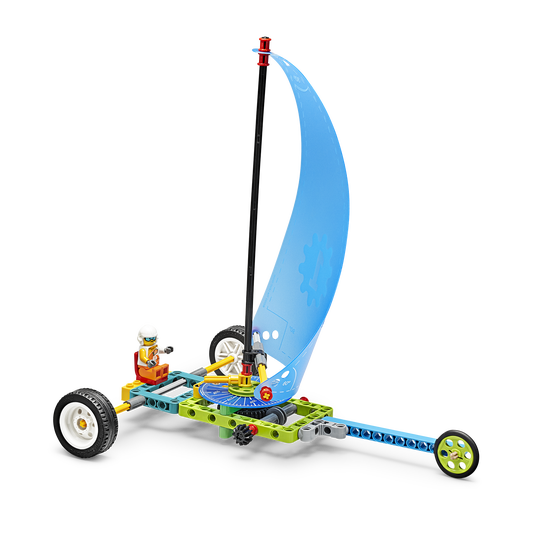Education with LEGO® BricQ Motion is a STEAM project that allows elementary and middle school kids to play with forces, motion, and relationships in the setting of sports. BricQ Motion provides students with simple, hands-on learning activities that result in cool “aha” moments as they set LEGO bricks in motion without the need of technology.
This hands on approach to education has been widely accepted and adopted in Dubai and other countries in the Middle East, This approach not only empowers students to apply the knowledge they learn in practicality.
Your elementary children will learn about forces and motion as they plan and execute investigations with LEGO Education BricQ Motion Essential. Lower primary students will investigate if design ideas for changing the speed or direction of an object with a push or a pull function as intended in the curriculum subject Train to Win. Upper elementary students will study patterns in object motion in the curriculum unit winning with Science, honing and honing their ability to predict future motion.
In an ever changing world developing new skills and adopting to them has become second nature, students have to compete on a whole new level in this century. Which is why Dubai and other countries in the Middle East have been rapidly adopting to newer methods of learning like developing inquiry skills, here’s how they are doing it:
LEGO® BricQ Motion is intended to assist non-specialist science teachers in improving inquiry abilities in younger children. It uses the Submarine STEM Submarine Shape Investigation as an example.
Students investigate the optimal shape for a “submarine” in this investigation. They do this by dropping various modelling clay shapes into a cylinder of water and measuring how long it takes them to sink.

Create a question
It is critical to structure the question correctly in order for it to be testable. A scientific experiment can be used to study a testable question.
Consider the question, “What is the best submarine shape?” What kind of tests might students conduct?
To make this question testable, we must first define the term “best.” In this example, the “submarine” descends slowly enough to reach the cylinder’s bottom in a certain period of seconds.
So, rephrase the question: ‘What submarine shape falls at the proper rate?’
Determine the variables
Allow the pupils to play and practise with the equipment if the opportunity occurs before the research begins in earnest. This can assist students in becoming familiar with the procedure, as well as provide an opportunity to highlight any issues with the method that can be addressed before the experiment begins.
Students will be able to more quickly recognise the factors involved as a result of this experience. What can they do differently? What do they have to keep the same?
In this experiment, the students can modify a number of input variables (independent variables), however the shape is the variable that is considered to be explored for the purposes of this lesson. That is what our query is attempting to determine.


Prepare for the investigation
Because the parameters of the research will rely on the actual equipment and apparatus available in the school, it is strongly recommended that the instructor does a trial run before the lecture.
The research Activity Overview lists suggested equipment and sizes, but this experiment can be done using similar equipment that is more widely available.
The goal is for the student to develop a modelling clay shape that falls through a cylinder of water in seven-seconds – not too quickly, nor too sluggish. For safety reasons, submarines must descend in a controlled manner.
Encourage your kids to foresee the future. This is how genuine scientists work! Inquire of your students why scientists make predictions. A prediction is what a scientist believes will occur.
A prediction is based on previous experiences and observations, not just a hunch. This past experience has given them an intriguing concept or a pattern to research.
Scientists keep track of their findings to evaluate if their hypothesis or forecast is right. These outcomes are frequently presented as data, such as the time it takes the “submarine” to fall through the ocean.
Students should keep track of each shape by drawing or identifying it, as well as the time it took to descend down the cylinder. They should also leave room for three findings for each shape that is assessed.
Students should be encouraged to continue their experiment in whatever way they see fit.
Maybe the kids didn’t find a shape that met the deadline, but two that came close? They could tweak these forms based on the other information they’ve gathered.
Students should test their hypothesis using the data collected throughout their experiment.
After determining if their results support or refute their hypothesis, they should assess whether their results were achieved honestly. After all, results that support or refute a theory are meaningless unless they were gained through a fair test!
Conclusions should be developed based on the students’ observations and outcomes, as well as the scientific principles given in the session.
Do the findings of a student match the scientific theory? Are ‘flatter’ forms generally slower? Is it due to the surface area and forces at play?

